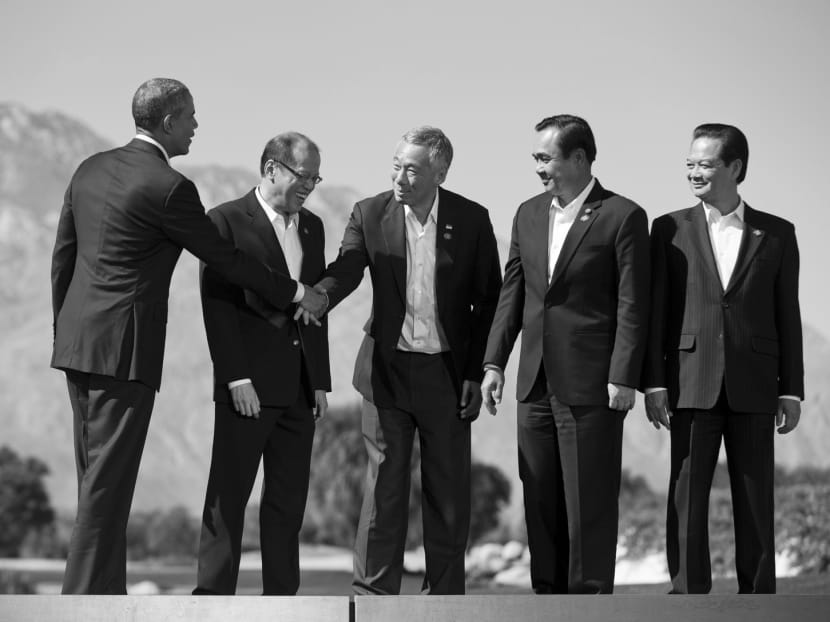Integration can keep ASEAN above US-China fray
Many features of the United States-Soviet Cold War are present in contemporary US-China relations: Ideological competition, struggles over the control of natural resources and old-fashioned rivalry for leadership of the global community.

US President Barack Obama with ASEAN leaders in Sunnylands, California, in February. With US-China tensions at a medium level, ASEAN countries would profit from the separate efforts of both countries to ‘win friends and influence people’. Photo: AP
Many features of the United States-Soviet Cold War are present in contemporary US-China relations: Ideological competition, struggles over the control of natural resources and old-fashioned rivalry for leadership of the global community.
The question for the Association of South-east Asian Nations (ASEAN) is: What is the likelihood of a Cold War between the US and China taking place on South-east Asian soil? And what can be done to prevent a new Cold War? Optimists among us would say that both presidents Xi Jinping and Barack Obama are fully cognisant of the tremendous waste such a confrontation would entail. More importantly, neither the Chinese nor the Americans fear or dislike each other enough to support another Cold War.
But our species can be short-sighted or short-tempered. The inescapable fact is that there will always be conflicts of varying intensity between nations. In a low-level conflict, China and the US would be able to resolve differences through bilateral diplomatic means, and South-east Asia would be left to its own devices by default through benevolent neglect.
With US-China tensions at a medium level, ASEAN countries would profit from the separate efforts of both countries to “win friends and influence people”. This is why China bought a possibly overpriced power station from the now-infamous 1Malaysia Development Berhad, why President Obama played golf with Malaysian Prime Minister Najib as a show of political support, why China made a more generous offer than Japan to build the high-speed railway connecting Bandung and Jakarta, and why the US granted extraordinary exemptions to Vietnam and Malaysia in the Trans-Pacific Partnership (TPP) negotiations. More recently, in February this year, President Obama hosted a special get-together for ASEAN leaders in Sunnylands, California.
A high-level conflict would see tensions like those at the height of the US-Soviet Cold War. To ASEAN’s detriment, both the US and China would adopt the stance “if you are not with me, then you are against me”. ASEAN cannot be a bystander in the present intensification of US-China rivalry. Its members must now work together on three fronts.
The first front is to work with other countries and international bodies (such as the United Nations, the European Union, the Organisation of Islamic Cooperation and the African Union) to strengthen existing global mechanisms for mediating conflict, such as the International Court of Justice and the World Trade Organization.
The second front is to establish a strong regional mediation institution located in South-east Asia itself. The question is whether it can be built without China’s support. It is generally to China’s advantage to delay the establishment of such an institution. China can count quite confidently on being an even bigger economic and political power in the future, and hence would have a bigger influence on an institution founded at a later time. ASEAN has to make China realise that this future advantage must be weighed against the greater risk of driving ASEAN irreversibly closer to the US in the present.
The third front is for ASEAN to hasten its rise as an integrated economic powerhouse. ASEAN has to be important enough to the US and Chinese economies for them to acquiesce to its requests to strengthen global institutions and to participate in the ASEAN regional mediation mechanism.
ASEAN economic integration will require every member to undertake two sets of reforms. The first is to boost economic development in each country. For example, Malaysia and Thailand, the two most advanced ASEAN countries after Singapore, have been caught in the middle-income trap since 1995. ASEAN countries must implement important regulatory reforms to terminate the privileged positions of inefficient but politically connected firms. Education systems must be brought to the level of those in Japan, Hong Kong, South Korea and Australia.
The second set of reforms is to achieve the declared objectives of the ASEAN Economic Community (AEC). The AEC must become as integrated economically by 2020 as the North American Free Trade Agreement is today. ASEAN members should also embrace integration with the US through the TPP and with China through the Regional Comprehensive Economic Partnership.
Economic integration will result in losers as well as winners. Because the gains of the winners will exceed the losses of the losers, ASEAN must mobilise some of those gains to fund compensation programmes. These should include trade adjustment programmes to facilitate the transition of displaced workers to new jobs.
In keeping with social justice, Malaysia should temporarily subsidise the drugs that increase in price due to the TPP. The reason the TPP debate was particularly rancorous in Malaysia was because of the government’s failure to extend any meaningful trade adjustment assistance to those hurt by TPP membership.
These reforms must be implemented simultaneously. Their interaction will speed up the emergence of ASEAN as a world economic power. For example, ASEAN members’ commitments to bring the AEC to fruition within a specified time period can be invoked against interest groups blocking badly-needed reforms.
The prudent strategic response by ASEAN to the US-China rivalry is to first strengthen global institutions and establish a regional mediation mechanism, and, second, to enact the reforms necessary to create an economically powerful AEC. The best defence is a strong regional economy. ASEAN should convert the US-China threat into an opportunity for a region-wide economic integration. EAST ASIA FORUM
ABOUT THE AUTHOR:
Wing Thye Woo is president of the Malaysia-based Jeffrey Cheah Institute on Southeast Asia. He is also a professor at the University of California, Davis, and at Fudan University.






